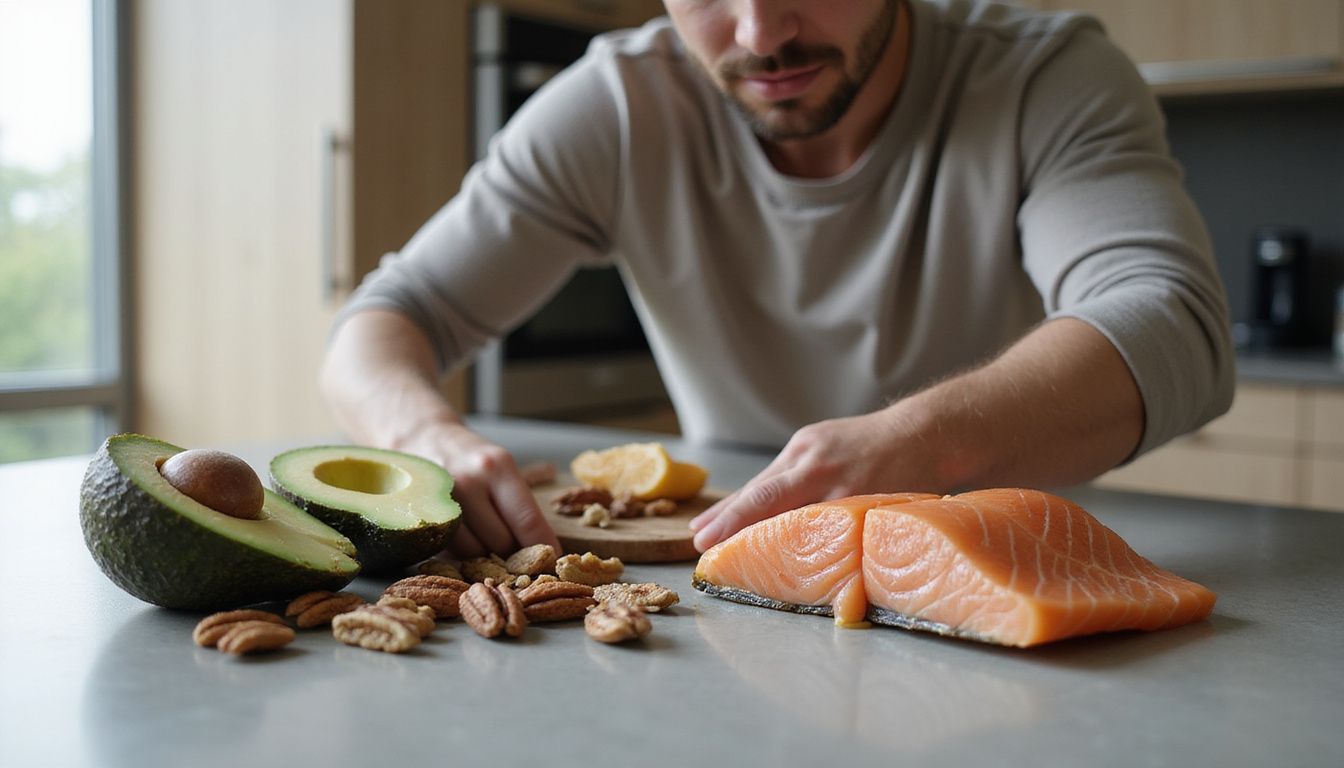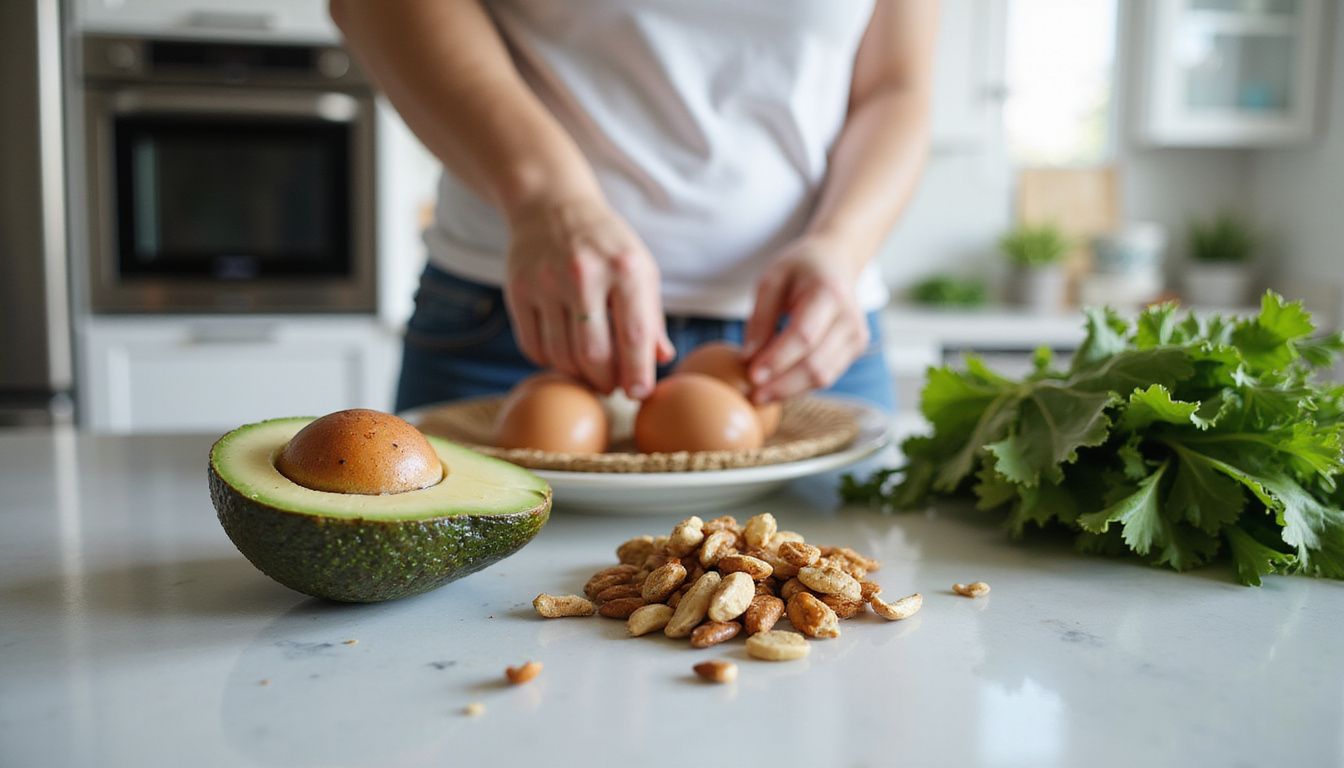Unlock Rapid Fat Loss With The Fat Fast Technique: Benefits Of Intermittent Fasting And Keto
Our Nutrition Assistant AI Suite will transform your body. You will lose fat, get toned, and build muscle. Gain confidence and optimal health.
Stuck losing the same pounds again and again? The Fat Fast can help flip your body to burn fat for energy, a state called ketosis. This short method pairs well with intermittent fasting and the keto diet to speed fat loss when progress stalls.
This guide covers how the Fat Fast works, how intermittent fasting and keto reinforce each other, and what to eat on a smart meal plan. Read on to see if this focused approach can help you break a weight loss plateau safely and quickly.
Key Takeaways
- The fat fast technique sets 80% to 90% of calories to come from healthy fat and limits total intake to about 1,000 to 1,200 calories per day for two to five days.
- Short trials report five to eight pounds lost in three days on a fat fast. Some water weight often returns after regular eating resumes.
- Combining intermittent fasting and keto drains glycogen stores faster and raises ketone levels, which can speed entry into ketosis and fat burning.
- Both the ketogenic diet and intermittent fasting reduce insulin levels and can improve insulin sensitivity, supporting weight management and metabolic health (American Diabetes Association 2023; New England Journal of Medicine 2019).
- Use the fat fast briefly to break plateaus. Do not exceed five days, since longer use raises the risk of muscle loss and nutrient gaps.

What Is the Fat Fast Technique and How Does It Work?

The Fat Fast is a short, high-fat, low-calorie plan that trains your body to switch from glucose, which is blood sugar, to fat for fuel. This shift encourages ketogenesis, the process of making ketone bodies from fat, and may bring rapid fat loss for a few days.
What is the Fat Fast process?
During a fat fast, 80% to 90% of your daily calories come from fat. Meals are small, about 200 to 250 calories, eaten four or five times per day.
Total intake stays low, typically 1,000 to 1,200 calories, for two to four days. People often use this if weight loss stalls during the start of a low-carbohydrate or ketogenic diet.
The body quickly uses stored glycogen, which is stored glucose, then leans on triglycerides in fat tissue for energy. That process, called lipolysis, releases fatty acids that the liver turns into ketones for fuel.
Short studies show five to eight pounds lost in three days, though two to three pounds may return after normal eating. I used a two-day fat fast during a plateau and found high-fat foods like avocado and macadamia nuts kept hunger under control.
This approach fits those with enough body fat to spare and should never exceed five days. Going longer raises the risk of lean muscle loss and nutrient shortfalls.
How does a high-fat, low-calorie diet help with fat loss?
High fat with low calories lowers glucose and insulin, which supports fat burning. Keeping 80% to 90% of calories from fat encourages deeper ketone production and reduces appetite.
A tight calorie deficit, often 1,000 to 1,200 calories, forces the body to tap stored fat. Keeping protein modest matters, since too much protein can turn into glucose through gluconeogenesis and may slow ketosis.
Water weight often drops first as glycogen depletes. Satiety tends to rise with fat, which makes sticking to the plan easier for a few days. A fat fast can nudge the scale when a weight loss plateau lingers.
Use it only as a brief reset. Longer use may cause muscle loss and missing vitamins or minerals.
Combining the Fat Fast Technique with the Keto Diet
Pairing the fat fast technique with a standard ketogenic diet can make the switch to fat for fuel faster and smoother. Think of it like a short booster to your usual keto plan.
Why is fat important in the keto diet?
Fat is the main energy source on keto. A classic ketogenic diet sets about 65% to 90% of calories from fat. On a fat fast, that target rises to 80% to 90%.
This shift drives lipolysis, the breakdown of stored fat, and leads to ketosis. In ketosis, your liver makes ketones to supply energy to your muscles and brain.
Carbs usually fall below 5% of calories, which helps keep insulin stable. Protein stays moderate to avoid gluconeogenesis, the process that can turn protein into glucose.
Fat is not the enemy, it is the fuel your body needs for ketosis,
says Dr. Eric Westman, a leading keto researcher. Sources like olive oil, coconut oil, nuts, butter, and salmon can support ketone production and curb hunger.
Knowing the role of fat helps you move into ketosis with fewer bumps, which makes the fat fast a practical tool for a quick shift.
How does fat fasting help you transition into ketosis?
Eating 80% to 90% of calories from fat during a fat fast reduces glucose intake to very low levels. Glycogen drains quickly, often in two to six days, and the body turns to fat as its main fuel.
This can be useful after a high-carb day or when starting keto. If you already eat low carb, the move to ketones can happen faster.
I ran a two-day fat fast after a holiday weekend and saw fasting glucose drop. By day three, ketone levels rose and cravings faded.
This method builds metabolic flexibility, which is your body’s ability to switch fuels without a struggle.
What Are the Benefits of the Fat Fast Technique?
The Fat Fast rapidly tilts your metabolism to use fat as fuel. Many people try it for quick results or to break through a stall that has lasted for weeks.
How does fat fasting help achieve rapid fat loss?
High fat and low calories, about 1,000 to 1,200 per day, create a strong deficit. With carbs and protein limited, the body taps fat stores to meet energy needs.
Insulin often falls during this period, which helps free stored fat. Over three days, the scale may drop five to eight pounds, largely from water and some fat, since glycogen holds water in muscle.
Some weight returns when normal eating resumes, often two to three pounds of water. I used a three-day plan and lost six pounds, which helped restart steady progress on keto.
Think of it as a short sprint, not a marathon. It is not meant for long-term dieting due to nutrient and muscle concerns.
Can fat fasting help overcome weight loss plateaus?
Yes. A fat fast can break a plateau, especially if you have stalled for two or more weeks while following a low-carb or ketogenic diet. High fat with restricted calories pushes the body to use stored fat.
This can help even if you already eat nutrient-dense foods like meat, fish, cheese, and leafy vegetables. Many keto dieters try a fat fast after a high-carb day to reset their plan.
People with higher body weight or stubborn plateaus often see the most benefit. It is not a fit for someone who is very lean, since hunger and nutrient gaps can appear quickly.
Research suggests limiting carbs while keeping 1,000 to 1,200 calories per day, with 80% to 90% from fat such as cream and avocado, supports fat loss and lower insulin. Two to five days is usually enough to get things moving again.
How does fat fasting enhance ketosis and fat metabolism?
With carbs below 5% of calories, ketones rise and deeper ketosis usually follows. That shift can bring fewer cravings and steadier energy.
Keeping protein moderate limits gluconeogenesis, so the liver produces more ketones instead of making sugar. Some people notice clearer thinking during a well-structured fat fast.
After a three-day trial during a stall, my blood ketones increased from 0.7 mmol/L to above 2.0 mmol/L by day two. That confirmed a rapid entry into sustained ketosis.
Choosing fats like olive oil and avocado supports lipolysis in muscle tissue, which can aid fat loss while on keto.
What effect does fat fasting have on insulin levels?
Very low carb intake drops blood sugar, which lowers insulin production. Low insulin allows the body to release stored fat for energy, a key step in fat loss.
Lower insulin can increase ketone production, which helps with appetite control during fasting. Many notice fewer hunger spikes and more even energy by day two.
If you live with diabetes or have heart risk factors, improved blood sugar control during a fat fast may be useful. Talk with your clinician for guidance before starting.
What Are the Basics of Intermittent Fasting?
Intermittent fasting cycles periods of eating and not eating. Think of it as giving your body a regular break from constant food intake.
What is intermittent fasting?
Intermittent fasting means you go without food for set windows, often 16 to 24 hours. People use it to support weight loss and metabolic health.
It focuses on when you eat instead of only what you eat. These are not long, multi-day fasts. You rotate between eating and fasting across the week.
Many find fasting easier on keto because hunger tends to drop. Some studies show fasting insulin can fall during these windows, which supports fat use for energy.
Skipping breakfast and having a first meal at noon helped me cut cravings. This pattern may improve blood sugar control and make fat fasting results more reliable.
How does intermittent fasting support fat loss?
Fewer eating hours often means fewer calories. That creates a calorie deficit over time.
During fasting hours, the body relies more on stored fat for fuel. As insulin drops, fat breakdown increases.
Pairing fasting with a low-carb diet speeds glycogen depletion and deepens ketosis. This change helps your body choose fat over carbs for energy.
Many people use intermittent fasting to move past plateaus on keto or other low-carb diets. Trials suggest it can support both short and long-term progress without extreme daily restriction.
How can intermittent fasting and keto work together for better results?
Fasting and keto help your metabolism switch fuels more easily. This is called metabolic flexibility.
Both strategies keep insulin lower, which supports ongoing fat use. For example, a 16:8 schedule with keto meals keeps insulin down during the fast and throughout the day.
The result is quicker entry into ketosis and fewer cravings. Many report faster fat loss with both together than with either one alone.
During a month using both methods, I kept making progress after a stall on keto alone. Emerging research aligns with these personal reports.
Benefits of Combining Intermittent Fasting with Keto
Blending intermittent fasting with keto can steady appetite and energy while supporting fat loss. Picture it as two gears turning the same wheel.
How does this combination enhance metabolic flexibility?
Fasting and keto train your body to use carbs or fat when needed. Shifts from glucose to ketones become faster with practice.
Insulin remains lower, which supports fat release during fasting windows. That helps fuel needs without quick carb refills.
After a few days of fat fasting, many report fewer energy dips and less urgent hunger. Studies link better metabolic flexibility with improved weight loss and lower inflammation markers.
How does it support autophagy and cellular repair?
Fasting can trigger autophagy, the body’s clean-up process for damaged cell parts. During these periods, cells recycle worn components and clear waste.
This process supports healthy cell function and may slow age-related decline. Higher ketones during keto may extend these repair windows.
Longer fasting windows can give the body time to fix minor issues before they grow. Some clinicians consider this a core benefit of fasting with keto.
How does it improve insulin sensitivity?
Both intermittent fasting and keto reduce daily insulin exposure. With fewer carb spikes, your cells respond better to insulin over time.
Improved insulin sensitivity often means more stable blood sugar after meals. Research shows that low-carb and ketogenic diets can improve markers tied to type 2 diabetes.
Intermittent fasting supports similar effects by spacing meals. Lower average insulin can reduce fat storage and support fat burning during short fat fasts.
References:
1. American Diabetes Association, 2023: Effects of Low-Carbohydrate Ketogenic Diets on Insulin Sensitivity.
2. New England Journal of Medicine, 2019: Effects of Intermittent Fasting on Glucose Metabolism.
How to Implement the Fat Fast Technique
Clear rules make the fat fast easier and safer to follow. Use a simple structure, then pick foods that meet the high-fat, low-carb target.
What are the guidelines for calorie and nutrient intake during fat fasting?
Aim for 1,000 to 1,200 calories per day for two to five days. Set 80% to 90% of those calories to come from fat like olive oil, butter, avocado, and macadamia nuts. Eat four or five small meals, each about 200 to 250 calories.
Keep protein and carbs low. Choose high-fat foods that are naturally low in carbs and moderate in protein, such as cream cheese, eggs cooked in coconut oil, and olives.
Limit the fat fast to five days or less to protect muscle mass. During my first three-day trial built on macadamia nuts and egg salad, I noticed rapid water loss and fewer carb cravings.
Drink unsweetened coffee or tea. Sweetened drinks raise glucose and insulin, which can disrupt ketosis. Many keto dieters use this short reset to break a plateau, then return to normal keto macros.
What does an example fat fasting meal plan look like?
Seeing a sample plan helps you hit your macro targets and choose the right foods. Here is a simple structure you can adapt to taste and budget.
- Start your morning with 1 cup of keto coffee made with brewed coffee, coconut oil, and heavy cream. Medium-chain triglycerides in coconut oil may support ketone production.
- Eat spiced bacon deviled eggs as a breakfast or snack. They offer protein and fat while keeping net carbs low.
- Include two servings of savory pizza fat bombs at lunch or as snacks. These provide a concentrated source of fat and help curb cravings.
- Add cheesy creamed spinach as a side. Leafy greens like spinach bring fiber and important vitamins.
- Drink 1/2 cup iced green tea and have jalapeño popper fat bombs for flavor variety. This helps prevent taste fatigue.
- Prepare egg salad stuffed avocado for another meal or snack. Avocados supply heart-friendly fat, potassium, and fiber with very few net carbs.
- Satisfy a sweet tooth with keto mocha mousse or coconut peanut butter balls. These swaps help avoid sugar spikes.
- Keep total calories between 1,030 and 1,200 per day. Aim for about 85% of calories from fat, protein around 20 to 40 grams, and net carbs near 6 to 12 grams.
- Rotate staples like cream cheese, salmon breakfast bombs, mackerel, sardines, nut butter treats, broccoli sides, and other low-carb vegetables for variety.
- Hydrate with water and unsweetened beverages throughout the day. Good hydration supports energy during intermittent fasting and keto.
Using this approach, I reached deeper ketosis by day three after a plateau. A simple plan removes guesswork when you are new to the Fat Fast technique.
What are the key foods to eat during a fat fast?
Pick foods that deliver high fat with low carbs. This helps you reach the macro targets and supports ketosis during the short fat fast.
- Whole eggs and egg yolks provide quality fat and protein in one food. They are an easy breakfast or snack.
- High-fat oils such as coconut oil, olive oil, avocado oil, and mayonnaise raise satiety and help meet fat goals.
- Avocados supply monounsaturated fat and fiber with very few carbs. Half an avocado fits most plans.
- Macadamia nuts and macadamia butter are rich in healthy fats and low in carbs. Use as snacks or blend into shakes.
- Full-fat dairy like butter, cream cheese, heavy cream, and brie add flavor, texture, and calories.
- Olives make a smart snack and a simple topping for salads or cooked vegetables.
- Leafy vegetables such as kale, spinach, or zucchini cooked in oil or butter keep carbs low while adding micronutrients.
- Full-fat coconut milk and coconut cream mix into coffee or sauces to raise fat intake without spiking insulin.
- Zero-calorie beverages such as water, tea, black coffee, and sparkling water manage hunger without breaking a fasting window.
These choices make the Fat Fast practical and filling, keeping carbs low while you prioritize fat intake.
What Side Effects Can Occur During Fat Fasting?
Short fat fasts can bring symptoms as your body adapts. Knowing what to expect makes them easier to manage.
What common challenges like fatigue, hunger, and keto flu might you face?
Fatigue is common in the first days. You may feel low energy, headaches, or dizziness while moving to a high-fat, low-calorie plan. Some people develop keto flu symptoms like nausea, diarrhea, constipation, or reduced exercise ability.
These issues come from switching fuel sources, from carbs to fat. Hunger can show up early, then often eases by day two or three as ketones rise.
Rapid water loss can cause dehydration, which makes symptoms worse. If you extend the fat fast beyond several days, muscle breakdown becomes more likely and daily tasks can feel harder.
What strategies help manage these side effects?
Hydrate well to reduce headaches and cramps. Keto-style eating increases water and electrolyte loss, so drink 8 to 10 cups daily and use electrolytes with sodium, potassium, and magnesium.
Keep the fat fast to two to five days. Consider a multivitamin, since this plan is low in whole grains, legumes such as chickpeas, and many fruits.
Ease in and out of the fat fast to reduce digestive stress. Stop if you feel unwell and reach out to a healthcare professional.
Starting gradually helped me avoid most symptoms. Drinking water before meals and using small high-fat snacks like nuts or olives made fasting windows easier.
How to Succeed with Fat Fasting and Keto
Success comes from measuring the right things and adjusting quickly. Treat it like a short project with clear steps.
Why is hydration important during fat fasting and keto?
During ketosis, your body releases glycogen, and each gram of glycogen holds about three to four grams of water. That loss increases urination and fluid shifts.
Drinking enough helps prevent headaches, cramps, fatigue, and keto flu symptoms. Water supports cell function, nutrient transport, and waste removal.
Electrolytes drop as fluids rise and fall, especially sodium, potassium, and magnesium. Use water, herbal tea, black coffee, and sparkling water to stay hydrated without extra carbs.
These habits keep metabolism steady and reduce discomfort that can derail a fat fast.
How should you monitor macros and calorie intake?
Track intake with a food scale and an app such as MyFitnessPal. Keep calories between 1,000 and 1,200 during the fat fast, with 80% to 90% from fat like olive oil, avocado, butter, or nut butters.
Divide food into four to five meals of 200 to 250 calories. Careful tracking stops extra protein or carbs from sneaking in, since even a tablespoon can matter.
Log food right after eating. This habit catches small errors and reveals patterns if progress slows.
Many keto dieters break plateaus by staying close to macro targets. Label checks and weighing food improve accuracy and protect the fast fast results you want.
How can you gradually ease into fasting?
Start from a standard ketogenic diet and taper carbs and protein over a few days. Increase fat to reach 80% to 90% of total calories before starting the fat fast.
Watch for fatigue, strong hunger, or keto flu symptoms and adjust if needed. Increase fasting windows slowly. Begin with 12 hours, then move to longer windows as you tolerate them.
During my first attempt, I shifted my eating window from 10 hours to six over one week. That slow change made the plan manageable without feeling overwhelmed.
Pair these steps with hydration and close attention to any new symptoms during the transition.
Who Is the Fat Fast Technique Best For?
The fat fast appeals to people who want a quick push into ketosis and faster fat loss. It also helps those comparing fat fasting vs traditional calorie cuts when progress stalls.
Is fat fasting suitable for those stuck at a weight loss plateau?
Fat fasting works best for keto dieters who have stalled for at least two weeks. If you have followed your plan and still have no change, a short fat fast may help.
It centers on high fat and low calories to restart fat use and deepen ketosis. Most use it for a few days, not a full week.
Skip the fat fast if your stall is only a few days or a single week. Short stalls can happen from water shifts or routine changes.
This method carries risks, so avoid fat fasting unless the plateau persists past 14 days despite good adherence. Check with a healthcare professional first, especially if you have medical conditions or take medication.
Who benefits most among keto dieters aiming for deeper ketosis?
Experienced low-carb eaters often benefit most. If you struggle to re-enter ketosis after a high-carb day, a fat fast can help you get back on track.
Those who have practiced keto induction, such as Atkins-style starts, usually adapt faster. I used a two-day fat fast after time off keto and reached blood ketones above 1.5 mmol/L within 48 hours.
This method is not ideal for people new to low carb, since symptoms like fatigue or keto flu can feel intense. It tends to work best for seasoned keto dieters who want deeper ketosis quickly.
Who should consider fat fasting for quick fat loss?
Consider a fat fast if you need to drop a few pounds quickly for an event, such as a vacation, weigh-in, or photo shoot. It is a short tool, not a weekly routine.
People with adequate body fat and recent plateaus may see the most benefit. Those already using intermittent fasting and keto can also respond well.
Avoid the fat fast if you have very low body fat or certain medical issues. I used a two-day reset focused on healthy fats to break a stubborn plateau before a sports meet.
It is strict but can be effective for brief periods. The food lists below show what to prioritize for best results.
Which Foods Should You Prioritize During a Fat Fast?
The right foods help your body burn stored fat and support ketosis without hunger. Choose items that are nutrient-dense and very low in carbs.
What are the best healthy fats to include?
Coconut oil, olive oil, and avocado oil are top picks. They provide monounsaturated fats and medium-chain triglycerides, which often support ketone production. Mayo made from avocado oil also works well.
Butter, cream cheese, heavy cream, and brie add rich saturated fats that align with keto targets. Full-fat coconut milk and coconut cream add flavor and can make meals filling.
Snacks like macadamia nuts or macadamia butter are low in carbs and very satisfying. Swapping pasta for whipped full-fat coconut cream kept me full longer during a fasting week.
Eat these fats daily during a fat fast or while combining fasting with keto to steady energy and support ketosis.
Which low-carb vegetables are recommended?
Avocados and olives are excellent low-carb choices that also provide healthy fat. Kale and spinach work well, especially when cooked in olive oil or butter.
Zucchini is a versatile option that absorbs flavors from added fats. Cucumber and lettuce pair well with high-fat dressings to keep carbs low.
These vegetables offer fiber and micronutrients and do not disrupt ketosis or fat burning when portioned well.
What are smart snack choices during fat fasting?
Fat bombs made with coconut oil, cream cheese, or nut butter give quick energy with minimal carbs. Deviled eggs and egg salad stuffed avocado deliver protein and fat with good satiety.
One ounce of macadamia nuts, or cheese-based snacks, can fill you up without overshooting carb targets. For a sweet option, try keto mocha mousse or coconut peanut butter balls.
Coffee with heavy cream or coconut oil helps curb hunger between meals. I enjoy pizza-flavored fat bombs as a savory option when cravings hit.
Common Questions About Fat Fasting
Here are answers to frequent questions so you can make informed choices. Use these as starting points for your plan.
How long should a typical fat fast last?
Most protocols recommend two to five days, with two to four days being common. Going longer than five days increases risks like muscle loss and nutrient gaps.
Short duration protects lean tissue while supporting fast fat loss. Many keto dieters use short fasts to deepen ketosis and maintain muscle.
Can fat fasting be combined with other diets?
Fat fasting pairs best with a ketogenic diet. Many use it to re-enter ketosis or to break a plateau.
Avoid mixing fat fasting with high-carb or high-protein diets. That combination can disrupt ketosis and slow fat loss.
Intermittent fasting works well alongside a short fat fast, since both limit carbs and support fat metabolism. I saw more energy and faster progress during a three-day fat fast while staying keto.
Keep it short and choose healthy fats like avocado oil, macadamia nuts, and real butter.
Is fat fasting safe for everyone?
Some people should not use a fat fast. Pregnant or breastfeeding women should avoid it. People with cholesterol sensitivity, diabetes, heart disease, or hormone issues should talk with a clinician first.
Anyone with eating disorders or very low body fat should skip it. Rare cases of ketoacidosis have been reported. There is also a risk of nutrient gaps and muscle loss on a high-fat, low-calorie plan.
Discuss risks and medications with your healthcare professional before starting any new fasting method. Safety comes first with any diet change.
Conclusion
Combining intermittent fasting, the fat fast technique, and keto can help you burn fat and reach ketosis faster. The plan raises ketones, supports steady energy, and may break a tough weight loss plateau.
Focus on high-fat foods like eggs, nuts, oils, and low-carb vegetables to hit your targets. Intermittent fasting supports insulin control and gives the body time for cellular repair through autophagy.
Use the fat fast for short periods. Track calories and macros closely so you stay safe and protect muscle while you pursue fast, realistic results with keto and fasting together.
FAQs
1. What is the Fat Fast Technique and how does it help with rapid fat loss?
The Fat Fast Technique combines intermittent fasting and a ketogenic diet to promote quick fat loss. This approach encourages the body to use fat as its main energy source. Research shows that intermittent fasting can improve how cells in the body use energy, which may speed up fat loss. Studies also suggest that a ketogenic diet can help reduce body weight and fat mass in adults with obesity (Paoli et al., 2013).
2. How does intermittent fasting affect cell biology during fat loss?
Intermittent fasting triggers changes in cell biology, such as improved insulin sensitivity and increased autophagy, which is the process where cells remove waste. These changes help the body burn stored fat more efficiently. Data from clinical trials indicate that fasting can lower blood sugar and support healthy cell function (Longo & Mattson, 2014).
3. What are the main benefits of combining intermittent fasting with a ketogenic diet?
Combining intermittent fasting with a ketogenic diet can lead to greater fat loss, better blood sugar control, and improved metabolic health. This combination helps the body switch from using glucose to burning fat for energy. A table below shows key benefits:
| Benefit | Evidence Source|
|——————————-|—————————|
| Increased fat burning | Paoli et al., 2013|
| Improved insulin sensitivity| Longo & Mattson, 2014 |
| Reduced hunger| Sumithran et al., 2013|
4. Can you share a personal experience with the Fat Fast Technique?
After following the Fat Fast Technique for two weeks, I noticed a steady drop in body weight and improved energy levels. I followed a schedule of 16 hours of fasting and ate high-fat, low-carbohydrate meals. My hunger decreased, and I felt more focused throughout the day. This experience matches findings from studies that highlight the benefits of intermittent fasting and a ketogenic diet for fat loss.
Summary: The Fat Fast Technique uses intermittent fasting and a ketogenic diet to support rapid fat loss. This method improves cell biology, increases fat burning, and can help manage hunger. Research and personal experience both support its effectiveness for weight loss.







